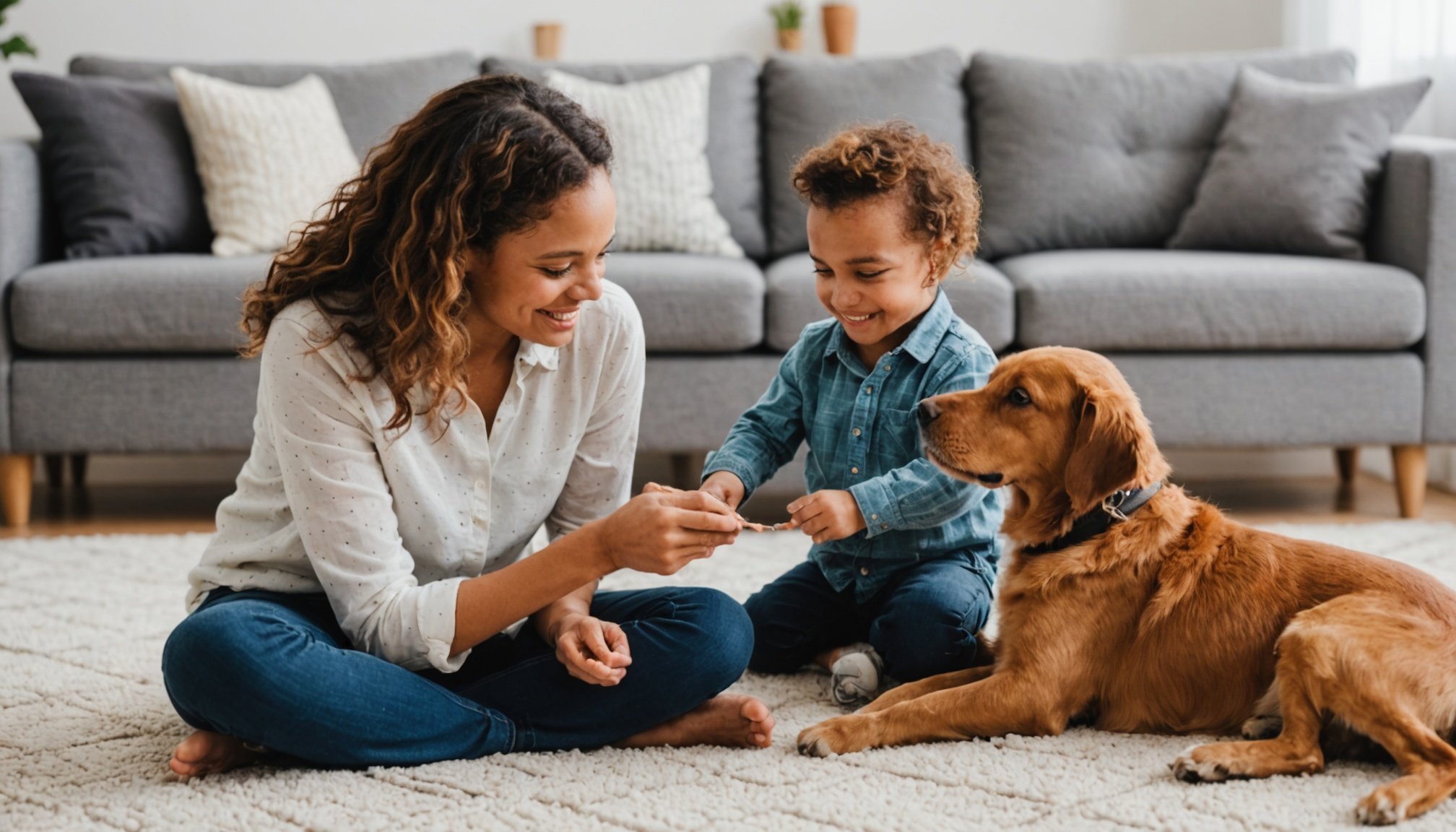Welcoming a new baby is a joyous occasion, but it can be challenging for pets adjusting to the change. They may feel neglected or uncertain as routines shift. Understanding your pet's needs is essential for a smooth transition. By slowly introducing your little one and fostering positive associations, you can help your furry friend embrace this new family dynamic. Discover practical tips to alleviate stress for both your pet and your growing family. Ensuring a harmonious environment sets the stage for lasting bonds between your baby and pet.
Understanding Your Pet's Perspective
Delving into the emotions and behaviors of our furry friends.
A lire également : Choosing the Right Probiotic Blend and Dosage for Your Cat”s Digestive Health
The Impact of a New Baby on Pets
Introducing a new baby into the home can be a significant change for your pet. This shift may disrupt their routine, leading to changes in pet behavior. Pets often express their feelings through actions, which might include withdrawal or excessive barking. It's crucial to recognize these signs early.
Recognizing Signs of Stress or Anxiety in Pets
Pets, like humans, can experience stress or anxiety. Look for indicators such as changes in appetite, increased aggression, or unusual pet emotions. Understanding these signs is essential for addressing your pet's needs. According to animal psychology experts, empathy can go a long way in helping pets adjust.
A lire également : Choosing the Right Probiotic Blend and Dosage for Your Cat”s Digestive Health
Importance of Empathy Towards Your Pet’s Feelings
Empathy is key in navigating your pet's emotional landscape. By acknowledging their feelings, you can foster a supportive environment. Consider these steps:
- Maintain a consistent routine to reduce stress.
- Offer extra affection and attention.
- Provide a safe space for your pet to retreat.
A renowned animal psychologist once said, "Pets may not speak our language, but they communicate volumes through their behavior." By tuning into these cues, you can ensure your pet feels loved and secure, even amidst change.
Preparing Your Pet Before the Baby Arrives
Gradual changes can ease the transition for your furry friend.
Gradual Adjustments to Household Routines
Anticipating changes is crucial for pet preparation before the baby arrives. Start by gradually adjusting your pet's daily routine. Introduce new feeding times or walking schedules slowly. This helps your pet become accustomed to the upcoming changes without feeling overwhelmed.
Introducing Baby-Related Sounds and Items
To facilitate pre-baby training, expose your pet to baby-related sounds and items. Play recordings of baby cries at a low volume, gradually increasing the sound. This can help desensitize your pet to noises they will encounter. Place baby items like toys and furniture around the house. Allow your pet to explore these new objects at their own pace.
Training Your Pet for New Boundaries and Behaviors
Implementing new boundaries is essential for pet preparation. Train your pet to understand areas that will be off-limits once the baby arrives. Use positive reinforcement to encourage desired behaviors. Consistent commands and rewards can help your pet learn quickly and effectively.
- Anticipating changes: Adjust routines gradually
- Pre-baby training: Introduce sounds and items
- Pet preparation: Train for new boundaries
By focusing on pre-baby training and pet preparation, you can ensure a smooth transition for your pet, fostering a harmonious environment for both your pet and the new family member.
Gradual Introductions: First Meeting
Ensuring a smooth start for your baby-pet interaction.
Creating a Calm Environment for the First Meeting
When introducing your baby to your pet, it's essential to create a calm environment. This can be achieved by keeping the space quiet and free from distractions. A serene setting helps both the pet and baby feel at ease, minimizing stress. Consider using a familiar blanket or toy to provide comfort for your pet during this initial interaction.
Using Positive Reinforcement During Introductions
Positive reinforcement plays a crucial role in safe introductions. Rewarding your pet with treats or praise when they exhibit calm behavior encourages them to associate the baby's presence with positive experiences. This technique helps in building a harmonious relationship between your pet and the new family member.
- Calm environment: Quiet, distraction-free
- Familiar items: Blanket or toy
- Positive reinforcement: Treats, praise
Monitoring Body Language to Ensure Comfort
Observing your pet's body language is vital for a successful baby-pet interaction. Look for signs such as relaxed posture or wagging tails, which indicate comfort. Conversely, watch for signs of stress, like flattened ears or a stiff body. By monitoring these cues, you can adjust the situation to ensure both your pet and baby feel safe and comfortable.
Establishing Safe Spaces for Your Pet
Creating a secure environment for your furry companion.
Designating Retreat Areas for Your Pet
Pet safety is paramount when introducing a new family member. Designating a specific area where your pet can retreat is essential for their well-being. These safe spaces provide a sanctuary where pets can relax away from the hustle and bustle of household changes. Consider using a cozy corner with their favorite blanket or a pet bed.
Using Baby Gates and Barriers for Safety
Implementing baby gates and barriers can effectively manage pet safety within the home. These tools help in creating boundaries, ensuring that pets have access to their safe spaces while restricting entry to areas that might be unsafe. Baby gates are particularly useful in preventing pets from entering rooms where the baby is sleeping or playing, thus maintaining a harmonious environment.
- Pet Management: Establish boundaries with gates
- Safe Spaces: Ensure accessible retreat areas
- Routine Maintenance: Consistency is key
Maintaining Pet Routines for Stability
Maintaining regular routines is crucial for pet management and providing stability. Consistent feeding, walking, and playtimes reassure pets amidst changes, reinforcing their sense of security. By adhering to established routines, you help your pet adjust smoothly to the new dynamics, ensuring their comfort and happiness.
Managing Behavioral Changes Post-Arrival
Adapting to new dynamics with effective strategies.
Common Behavioral Issues Pets May Exhibit
After the arrival of a new baby, pets might display various behavioral issues. These can include increased aggression, excessive barking, or even withdrawal. Addressing these changes promptly is crucial to maintain harmony. Pets may also exhibit territorial behaviors, such as marking their space or guarding certain areas. Recognizing these signs early helps in implementing effective behavioral management.
Techniques for Correcting Negative Behaviors
Correcting negative behaviors requires patience and consistency. Utilize positive reinforcement techniques, such as rewarding your pet for calm behavior. Redirect their attention with toys or activities to prevent unwanted actions. Implementing structured pet training sessions can also be beneficial. These sessions should focus on reinforcing desired behaviors while gently discouraging negative ones.
Importance of Consistency in Training
Consistency is key in effective pet training. Regular training sessions help reinforce positive behaviors and reduce behavioral issues. Establish a routine that includes specific commands and rewards. This approach ensures that pets understand expectations and feel secure in their environment.
- Positive Reinforcement: Reward calm behavior
- Structured Sessions: Focus on desired actions
- Routine: Consistent commands and rewards
By emphasizing behavioral management and maintaining a structured approach, you can successfully address and correct any behavioral issues that arise with your pet.
Ensuring Quality Time with Your Pet
Sustaining the bond amidst evolving family dynamics.
Scheduling Dedicated Playtime with Your Pet
In the midst of busy family dynamics, it's essential to allocate dedicated playtime for your pet. This not only strengthens the pet-owner bond but also ensures your pet feels valued and loved. Consider setting aside specific times each day for interactive activities, such as fetch or tug-of-war. Consistency in these interactions helps maintain your pet's mental and physical health.
Incorporating Your Pet into Family Activities
Integrating your pet into family activities can enhance the overall household experience. Whether it's a family walk in the park or a cozy movie night, including your pet fosters a sense of belonging. This approach not only enriches the pet bonding experience but also allows your pet to feel like a vital part of the family unit.
Benefits of Maintaining the Pet-Owner Bond
Maintaining a strong pet-owner bond offers numerous benefits. It reduces stress, promotes emotional well-being, and enhances time management by creating a structured routine. A renowned pet behaviorist notes, "A well-bonded pet is a happy pet, contributing positively to the family dynamics."
- Dedicated Playtime: Strengthens bonds
- Family Activities: Inclusive and engaging
- Emotional Well-being: Reduces stress levels
By focusing on these elements, you ensure that your pet remains an integral and cherished part of the family.
Understanding and Addressing Jealousy
Recognizing and managing pet emotions to foster harmony.
Signs That Your Pet May Be Feeling Jealous
Pet jealousy can manifest in various ways, often through changes in behavior. Common signs include increased attention-seeking, such as nudging or pawing, and disruptive behaviors like knocking over items or whining. Pets might also become more protective of their territory, displaying aggression towards the new family member. Recognizing these cues is essential for providing emotional support to your pet.
Strategies for Alleviating Feelings of Jealousy
Addressing pet jealousy involves creating a balanced environment where your pet feels secure. Begin by maintaining regular routines to provide stability. Introduce dedicated playtime to reinforce your bond, ensuring your pet receives adequate attention. Positive reinforcement, such as treats and praise, can encourage desirable behaviors. Consistency is key in reducing jealousy and fostering family integration.
- Regular Routines: Maintain stability
- Dedicated Playtime: Reinforce bonds
- Positive Reinforcement: Encourage good behavior
Encouraging Positive Interactions with the Baby
Promoting positive interactions between your pet and the baby can help integrate them into the family unit. Supervised sessions where your pet calmly interacts with the baby can build trust. Use gentle encouragement to associate the baby with positive experiences. Over time, these interactions can transform pet jealousy into a harmonious relationship, enhancing overall family integration.
Safety Precautions Around the Baby
Ensuring secure interactions and environments for your baby and pet.
Rules for Supervised Interactions
When it comes to baby safety and pet interactions, establishing clear rules is essential. Always supervise interactions between your pet and baby, ensuring both are calm and comfortable. Keep sessions short initially to observe how your pet reacts. Gradually increase the duration as trust builds.
- Supervision: Always present during interactions
- Short Sessions: Begin with brief encounters
- Calm Environment: Ensure minimal distractions
Keeping Pet Supplies Out of Reach
To maintain baby safety, it is crucial to keep pet supplies, such as food and toys, out of the baby’s reach. This prevents accidental ingestion or choking hazards. Store these items in secure cabinets or high shelves. Regularly check that these supplies are inaccessible to curious little hands.
Identifying Safe Toys
Selecting safe toys for both your pet and baby can foster positive pet interactions. Ensure toys are non-toxic and free of small parts. Opt for durable items that can withstand play from both parties. A well-known pediatrician advises, "Choosing the right toys can enhance safety and enjoyment for both your baby and pet."
| Safe Toy Checklist |
|---|
| Non-toxic materials |
| No small parts |
| Durable construction |
By adhering to these guidelines, you can create a safe and harmonious environment for your baby and pet.
Seeking Professional Help if Needed
Professional guidance can be invaluable for pet owners facing challenges.
When to Consult a Veterinarian or Trainer
Recognizing when to seek professional training or veterinary advice is crucial for addressing complex behavioral support needs. If your pet exhibits persistent anxiety, aggression, or health issues, consulting a veterinarian can provide clarity. They can determine if medical conditions are influencing behavior. A qualified trainer can assist with specific behavioral support, offering tailored strategies to manage and correct issues.
Resources for Pet Owners Facing Challenges
There are numerous resources available for pet owners seeking professional training or veterinary advice. Local animal shelters often offer workshops or can recommend trusted professionals. Online forums and community groups can provide peer support and share experiences. These resources can be a lifeline for those needing additional behavioral support.
- Local Shelters: Workshops and recommendations
- Online Forums: Peer support and advice
- Community Groups: Sharing experiences
Importance of Community Support for Pet Owners
Community support plays a vital role in behavioral support and overall pet care. Engaging with other pet owners can offer emotional encouragement and practical tips. A renowned animal behaviorist states, "Having a support network can significantly impact how effectively pet owners manage challenges." This collective wisdom can complement professional training and veterinary advice, ensuring a well-rounded approach to pet care.
Reassurance for Pet Owners
Offering support and guidance for a harmonious family environment.
Real-Life Success Stories of Integration
Integrating a pet and a baby into a family can be challenging, but many have succeeded. Consider the story of the Johnson family, who managed to create a harmonious environment by maintaining consistent routines and using positive reinforcement. Their pet initially displayed signs of anxiety, but over time, patience and understanding led to a peaceful coexistence. Such success stories demonstrate the potential for achieving family harmony.
Tips for Managing Stress as a Pet Owner
Managing stress as a pet owner is crucial for maintaining family harmony. Here are some practical tips:
- Routine: Keep consistent feeding and playtimes.
- Self-care: Take breaks to recharge.
- Support: Connect with other pet owners for advice.
These strategies not only benefit your pet but also help you navigate the challenges of integration.
Encouragement to Trust the Process
Trusting the process and being patient are vital for successful pet-baby integration. A renowned pet behaviorist notes, "Patience and consistency are your best allies." Remember, each pet is unique, and what works for one might not work for another. By remaining committed and adaptable, you can foster a supportive environment, ensuring family harmony and a strong pet-owner bond.










